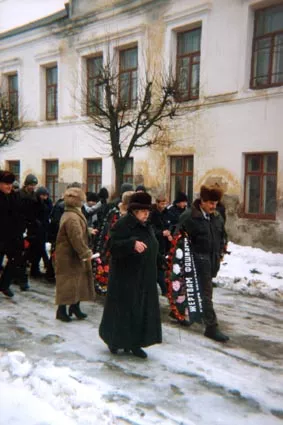Carrying funeral wreaths to the monument to Jews perished in Velizh
This photograph was taken in 1987 in Velizh of Smolensk region.
It shows the procession carrying funeral wreaths to the monument to Jews perished in Velizh.
My second husband, Aron Semenovich Leveter, lived in Velizh before the war broke out.
I was the second wife of Aron Semenovich. Before the war broke out he was married to Maria Berova. She gave birth to their daughter. Aron went to the front immediately after the war broke out.
When the Germans approached Velizh, my husband’s mother, his sister and his first wife with their little daughter in her arms left their native town on foot.
But the mother returned, she said she would be waiting for her son at home.
She didn’t manage to meet her son there: together with other Jews of Velizh she was put into a shed and burnt alive on 29th January 1942.
Aron Semenovich was at the front during the war. He was a driver of a Katyusha rocket launcher. The tragedy in Velizh, when all Jews there were burnt alive, happened in his absence. And in Velizh there were a lot of Jews, you could say Velizh was a Jewish shtetl.
On the place of that tragedy a standard obelisk was erected. In connection with it I’d like to tell you about a remarkable person: Alexander Grigoryevich Bourdukov. He was born in Velizh and at present works there as a teacher of history.
During the war he was a boy and lost his hand, having set off a mine.
The Fascists committed atrocities practically before his eyes.
I consider him to be a near saint.
He did his best to preserve the memory of Jews tormented to death in his native land during the war, it was his lifework. You see, under the Communists, the Soviet authorities didn’t speak about the Holocaust loudly.
It was considered a demonstration of dissidence. And for many years Alexander Grigoryevich collected pieces of information about those who’d perished or survived, about the history of the ghetto.
We got acquainted with him in 1987, when I came to Velizh. One large room in his house was filled with card files. It was his diligence that helped to erect a new good monument at the spot, where Jews were burnt alive.
There is also a museum, where a photo of my husband with all his war decorations hangs, among others.
They especially asked my husband to have his photo taken with all his orders and medals – not medal ribbons.
















